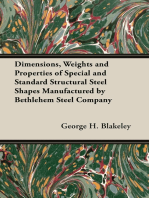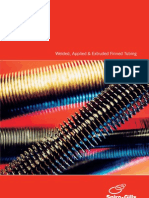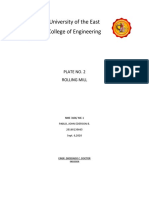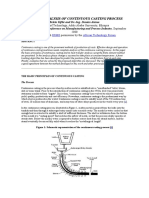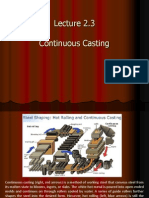0 ratings0% found this document useful (0 votes)
Notes Presentation
Notes Presentation
Uploaded by
osama raufCopper mould tubes are used in continuous casting machines for billet casting. Copper is used as the primary material for mould tubes due to its high thermal conductivity. The inner wall of the tube is plated with chromium to provide abrasion resistance at high temperatures. The length of copper mould tubes ranges from 500mm to 1200mm and is designed based on the required thickness of the solidified shell, casting speed, and machine cooling characteristics. Tube wall thickness varies from 10mm to 26mm depending on the size of the casting, with thicker walls used for larger sections. Corner radii of 3mm to 10mm are used depending on the section size to control heat transfer and reduce cracking in the solidified product.
Copyright:
© All Rights Reserved
Available Formats
Download as DOCX, PDF, TXT or read online from Scribd
Download as docx, pdf, or txt
Notes Presentation
Notes Presentation
Uploaded by
osama rauf0 ratings0% found this document useful (0 votes)
Copper mould tubes are used in continuous casting machines for billet casting. Copper is used as the primary material for mould tubes due to its high thermal conductivity. The inner wall of the tube is plated with chromium to provide abrasion resistance at high temperatures. The length of copper mould tubes ranges from 500mm to 1200mm and is designed based on the required thickness of the solidified shell, casting speed, and machine cooling characteristics. Tube wall thickness varies from 10mm to 26mm depending on the size of the casting, with thicker walls used for larger sections. Corner radii of 3mm to 10mm are used depending on the section size to control heat transfer and reduce cracking in the solidified product.
Copyright
© © All Rights Reserved
Available Formats
DOCX, PDF, TXT or read online from Scribd
Share this document
Did you find this document useful?
Is this content inappropriate?
Copper mould tubes are used in continuous casting machines for billet casting. Copper is used as the primary material for mould tubes due to its high thermal conductivity. The inner wall of the tube is plated with chromium to provide abrasion resistance at high temperatures. The length of copper mould tubes ranges from 500mm to 1200mm and is designed based on the required thickness of the solidified shell, casting speed, and machine cooling characteristics. Tube wall thickness varies from 10mm to 26mm depending on the size of the casting, with thicker walls used for larger sections. Corner radii of 3mm to 10mm are used depending on the section size to control heat transfer and reduce cracking in the solidified product.
Copyright:
© All Rights Reserved
Available Formats
Download as DOCX, PDF, TXT or read online from Scribd
Download as docx, pdf, or txt
0 ratings0% found this document useful (0 votes)
Notes Presentation
Notes Presentation
Uploaded by
osama raufCopper mould tubes are used in continuous casting machines for billet casting. Copper is used as the primary material for mould tubes due to its high thermal conductivity. The inner wall of the tube is plated with chromium to provide abrasion resistance at high temperatures. The length of copper mould tubes ranges from 500mm to 1200mm and is designed based on the required thickness of the solidified shell, casting speed, and machine cooling characteristics. Tube wall thickness varies from 10mm to 26mm depending on the size of the casting, with thicker walls used for larger sections. Corner radii of 3mm to 10mm are used depending on the section size to control heat transfer and reduce cracking in the solidified product.
Copyright:
© All Rights Reserved
Available Formats
Download as DOCX, PDF, TXT or read online from Scribd
Download as docx, pdf, or txt
You are on page 1/ 1
Copper mould Tube used in CCM machine for billet casting.
Casting : the making of an object by pouring molten metal or other material into a mould.
mold oscillation mechanism
5. Basic design of mold tube:
In this section some of the basic and important designing parameters for steel continuous casting mold
tubes is discussed.
5.1 Tube material: Due to high thermal conductivity copper is selected as primary constituent of mold
tubes. To prevent distortion of tubes alloying elements such as phosphorus, silver and Chromium-
Zirconium are added [16]. The inner wall of tube is plated with Chromium of 0.1 to 0.12mm thickness
to impart high temperature abrasion resistance.
5.2 Tube length: Length of copper mold tubes are designed based on thickness of solidified shell
required at the exit, casting speed and cooling characteristics of the casting machine. Tube lengths are
normally used in the range of 500mm to 1200mm [17]. The meniscus level of liquid steel is kept usually
in the range of 45mm to 200mm from top [16]. It depends on length of submerged entry nozzles (SEN)
dipping into liquid steel inside the mold. A deep meniscus level implies less SEN depth causing
turbulence in the meniscus and lubrication powder entrapment in the product. It also reduces the resident
time of liquid steel inside the mold. On the other hand, a shallow meniscus results in maximum distortion
in the fixation area of tubes at the top.
5.3 Tube wall thickness and corner radius: The tube thickness is estimated on the basis of its structural
distortion due to temperature rise and optimal heat transfer. The thickness of the wall of mold tubes
varies with size of casting. For billet casting of square sections of 100mm to 150mm the wall thickness
Fig. 5 Analysis domain with boundary conditions
is in the range of 10mm to 13mm whereas for bloom casting of square sections of 200mm it is 20mm.
For casting a section size of 350mm x 240mm, 26mm thick tube is used at Durgapur Steel Plant, SAIL.
Corner radius of mold tubes are given to control heat transfer at corner region to reduce air gaps. Park
et. al [18] explained that with higher corner radius susceptibility of formation of longitudinal corner
cracks in the cast product increases. With low corner radius due to off corner thinning of solidifying
shell the probability of off-corner cracks rises. Normally 3mm to 4mm corner radius is used for billet
casting up to size of 150mm square [16]. For bloom casting of section 200mm x 200mm and 350mm x
240mm rectangle, 6mm and 10mm corner radius is used respectively.
5.4 Tube Taper: Tapering in the inner wall of mold tubes are given to ensure contact between
solidifying steel shell and mold tube. A shrinkage study of steel shell formed during solidification is
done to predict the ideal taper. Taper can be single, double, triple, quadruple or parabolic, depending on
casting speed, tube length and grade of steel cast. Solidification model along with shrinkages is solved
in a 3D slice analysis domain as mentioned in the previous section without mold boundary to get the
free displacement at the periphery of casting, which in turn predicts the ideal taper for the mold. Tube
exit dimension are calculated considering shrinkages to get the final product dimensions.
5.5 Tube fixation and cooling water channel: Tubes are surrounded by stainless steel jackets and a
water gap is ensured between mold and jacket by supporting the tube against rivets. The arrangement is
shown schematically in Fig. 6. The number of rows of rivets depend on tube length and heat flux through
the tube. Structural analysis of tube with increased temperature is performed to decide the position of
rivets. In cold condition a gap, normally in the range of 0.4mm to 0.6mm, between mold tube outer walls
and rivets are kept to allow thermal expansion during casting.
You might also like
- Heat-Treatment of High Carbon Steel Wire - Patenting100% (1)Heat-Treatment of High Carbon Steel Wire - Patenting4 pages
- Dimensions, Weights and Properties of Special and Standard Structural Steel Shapes Manufactured by Bethlehem Steel CompanyFrom EverandDimensions, Weights and Properties of Special and Standard Structural Steel Shapes Manufactured by Bethlehem Steel CompanyNo ratings yet
- Awards and Decorations of The Philippine National Police88% (26)Awards and Decorations of The Philippine National Police2 pages
- Information of Steel Pipe and Method of Application1613scribdNo ratings yetInformation of Steel Pipe and Method of Application1613scribd2 pages
- Continuous Casting and Mould Level ControlNo ratings yetContinuous Casting and Mould Level Control15 pages
- Design Guidelines For PE & ROTO Lined Carbon Steel Piping100% (1)Design Guidelines For PE & ROTO Lined Carbon Steel Piping8 pages
- Continuous Casting and Mould Level ControlNo ratings yetContinuous Casting and Mould Level Control15 pages
- Analysis and Optimization of Parameters For Casting Ductile Iron PipesNo ratings yetAnalysis and Optimization of Parameters For Casting Ductile Iron Pipes27 pages
- Bolted Conn. With Hot-Dip Galv. Steel Memb.No ratings yetBolted Conn. With Hot-Dip Galv. Steel Memb.14 pages
- Eurocode 4 Seminar Composite Structures Composite Slabs With Profiled Steel Sheeting100% (1)Eurocode 4 Seminar Composite Structures Composite Slabs With Profiled Steel Sheeting23 pages
- University of The East College of Engineering: Plate No. 2 Rolling MillNo ratings yetUniversity of The East College of Engineering: Plate No. 2 Rolling Mill17 pages
- The Use of Serrated Metallic Gaskets On Air CoolersNo ratings yetThe Use of Serrated Metallic Gaskets On Air Coolers12 pages
- Thermal Analysis of Continuous Casting Process (Maryeling)No ratings yetThermal Analysis of Continuous Casting Process (Maryeling)10 pages
- Until Now, There Have Been 13 Types of Materials Popularly Used in Fabricating Chemical Vessels, Namely: Carbon SteelNo ratings yetUntil Now, There Have Been 13 Types of Materials Popularly Used in Fabricating Chemical Vessels, Namely: Carbon Steel9 pages
- Lecture Mechanical Design of Heat ExchangerNo ratings yetLecture Mechanical Design of Heat Exchanger46 pages
- Design Notes For ALL Memebres - Sefi ForumNo ratings yetDesign Notes For ALL Memebres - Sefi Forum17 pages
- Mechanical Engineering Manufacturing-Process Machine-Drawing Notes PDFNo ratings yetMechanical Engineering Manufacturing-Process Machine-Drawing Notes PDF10 pages
- The Jominy End Quench Test: HardenabilityNo ratings yetThe Jominy End Quench Test: Hardenability4 pages
- The Jominy End Quench Test: HardenabilityNo ratings yetThe Jominy End Quench Test: Hardenability4 pages
- Hydroforming Process of Thin Walled Tubular Components With Multiple Local BulgesNo ratings yetHydroforming Process of Thin Walled Tubular Components With Multiple Local Bulges18 pages
- Presentation On Pipes.: GET's EPCM Piping Department50% (2)Presentation On Pipes.: GET's EPCM Piping Department37 pages
- Welded, Applied & Extruded Finned TubingNo ratings yetWelded, Applied & Extruded Finned Tubing16 pages
- Unit 4 Analysis and Design of Special Structures ChimneysNo ratings yetUnit 4 Analysis and Design of Special Structures Chimneys15 pages
- Color Atlas Basic Technique for Metal Ceramics: An Introduction to Ceramic TechniqueFrom EverandColor Atlas Basic Technique for Metal Ceramics: An Introduction to Ceramic TechniqueNo ratings yet
- Water in Circular Economy and Resilience WICER The Case of Sao Paulo BrazilNo ratings yetWater in Circular Economy and Resilience WICER The Case of Sao Paulo Brazil8 pages
- Implementing Cisco Service Provider Next-Generation Core Network ServicesNo ratings yetImplementing Cisco Service Provider Next-Generation Core Network Services24 pages
- Investments in Equity Securities Answer KeyNo ratings yetInvestments in Equity Securities Answer Key6 pages
- Vapor-Liquid Equilibrium in Methyl Ethyl Ketone KetazineNo ratings yetVapor-Liquid Equilibrium in Methyl Ethyl Ketone Ketazine2 pages
- Project Report Computer Hardware Networking Mass Infotech (Cedti), Yamuna Nagar (Hariyana)No ratings yetProject Report Computer Hardware Networking Mass Infotech (Cedti), Yamuna Nagar (Hariyana)151 pages
- User's Guide: For Power Distribution Unit (PDU) in ION™ Optical Master UnitNo ratings yetUser's Guide: For Power Distribution Unit (PDU) in ION™ Optical Master Unit8 pages
- Magtag Covid Tracking Project Iot Display: Created by Lady AdaNo ratings yetMagtag Covid Tracking Project Iot Display: Created by Lady Ada30 pages
- Butterfly Electric Chimneys HOB - UpdatedNo ratings yetButterfly Electric Chimneys HOB - Updated22 pages



